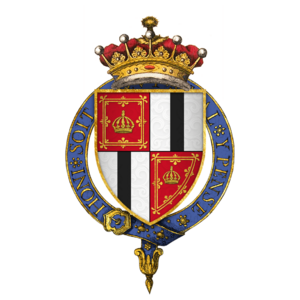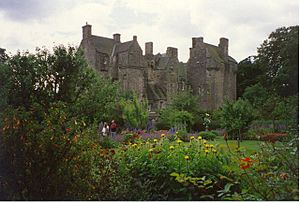Thomas Erskine, 1st Earl of Kellie facts for kids
Thomas Erskine, 1st Earl of Kellie (1566 – 12 June 1639) was an important Scottish nobleman. He was a close friend and helper to James VI of Scotland, who later became James I of England.
Early Life and Royal Friendship
Thomas Erskine was the oldest son of Sir Alexander Erskine of Gogar and Margaret Home. He grew up with James VI of Scotland and they went to school together. They became lifelong friends. Thomas worked for the King, even serving at his table. In 1585, he became a "Gentleman of His Majesty's Bedchamber," which meant he was a close helper to the King.
When King James married Anne of Denmark in 1589, he wrote some poems. Thomas Erskine's name was on some copies of these poems. This suggests he might have helped the King write them or shared them with others.
In 1593, King James asked Thomas Erskine to collect a special tax. This money was for the birth and baptism of Prince Henry, the King's son. At a special event during the baptism, Thomas Erskine joined the King in a tournament. They dressed up as Knights of Malta.
The King often gave gifts to his helpers. In January 1596, Thomas Erskine received a special locket with rubies and diamonds, and a gold ring with a diamond.
In 1600, Thomas Erskine was with the King during a dangerous event known as the Gowrie Conspiracy. The King was at the house of the Ruthven brothers in Perth and was thought to be in danger. Because Thomas Erskine was there to help the King, he was given some land from the Ruthven family. In 1604, he was given the title Lord Erskine of Dirletoun. He also became a "Privy Councilor" in 1601, which meant he advised the King. He even went on a special trip to France with the Duke of Lennox.
King James also sent secret letters to some of Queen Elizabeth's helpers. He hoped this would help him become the next King of England. One letter to Sir Robert Cecil had Erskine's family symbol and his initials "T. A." on it.
Life at the English Court
When King James became King of England in 1603, Thomas Erskine went with him. He continued to be a very important person at court. He became the Captain of the Guard (from 1603 to 1617) and the "Groom of the Stool" in 1604. These were important roles that kept him close to the King. In 1606, he was given the title Viscount Fenton.
Thomas Erskine often wrote letters to the Earl of Mar in Scotland. He shared news about politics and what was happening at court. In one letter from June 1612, he wrote about how the royal family was trying to save money: "There is much effort to make His Majesty's finances better. The spending is so great, much more than the income, that His Majesty will have to cut costs in his own house, the Queen's, and the Prince's house. They are doing this now."
In 1613, Thomas Erskine bought Kellie Castle and was given the land around it. On 23 April 1615, he received a very special honor: he was made a Knight of the Garter. He had a place to live at Theobalds House, near London.
In March 1619, he was given an even higher title: Earl of Kellie.
When King James died in March 1625, the King's advisors wrote a statement. Earl Kellie reminded them that King James liked to be called "King of Great Britain." He said that calling him "King of England and Scotland" would not please the people of Scotland.
Thomas Erskine died in London in 1639. He was buried in Pittenweem, Fife. His son, Alexander, had died before him in 1633. So, his grandson, Thomas Erskine, 2nd Earl of Kellie, became the next Earl of Kellie.
Family Life
The Earl of Kellie was married a few times. His first marriage was in 1587 to Ann Ogilvie. He later married Elizabeth Pierrepoint in 1604. He also married Dorothy Smith.



